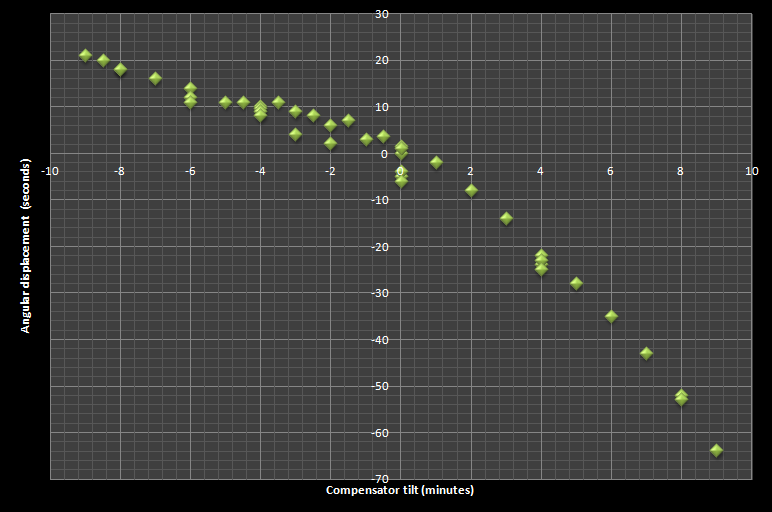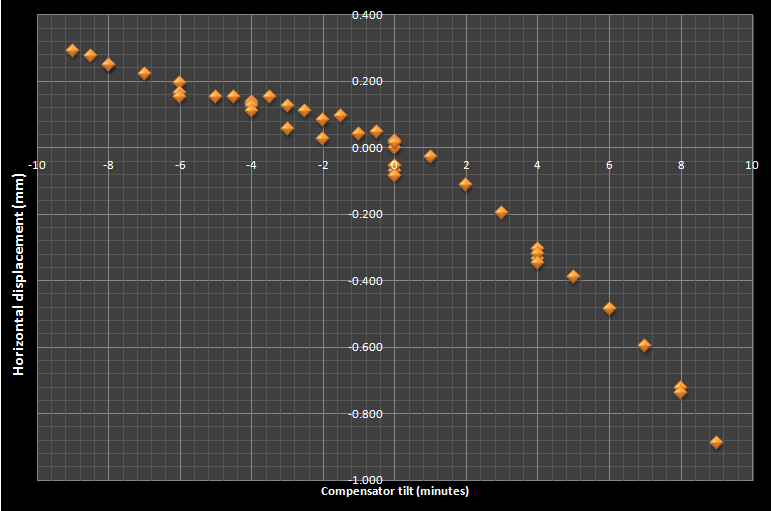Hello,
In response to the doubts expressed in the first thread about tribrach clamping accuracy I needed a way practically measure whether or not sub 0.1mm measurement was achievable with the setup I had going in my basement. Some suggested ways to either stop movement altogether or move the instrument a known quantity.
I believe I have devised an excellent way using the instrument and tribrach to create minute movements. The tribrach when combined with the tilt sensor of the instrument gives a way to displace the telescope horizontally (and vertically) by way of the footscrews. If we turn one footscrew the instrument will tilt, displacing the telescope horizontally in the process. the instrument looking perpendicular to the footscrew being turned will be displaced horizontally (and a bit vertically) from the target. The distance from the target multiplied by the sine of the change in angle required to split the target with the crosshairs will should be the displacement. This should agree with the calculated displacement by creating a model of how the instrument will tilt and displace according to the telescope height above the surface of the tribrach, and whereabouts the pivot point will be.
I'll spare you the dimensions of the equipment but the instrument should move about 0.54 mm when tilted 8' in either direction (0.11 mm total) which will represent a total angle of 1'17". It should also move about 0.14 mm vertically which is 11". Now if my measurements are better than 0.1 mm we should see a smooth(ish) graph of tilt vs. angular displacement (which will be converted into sideways displacement in mm). If not we should see noise and no pattern.
So, I set the instrument on the tripod and let it settle for hours to fully compress and distort/settle. I set up perpendicular to a wall target 2.865m distant. I set Hz=0 on the mark and started to wind the footscrew until i got to a nice round value on the digital bubble, wound off and wound back to the target consistently clockwise and noted the change in Hz. I went back and forth between -9' and 9' and recorded the results. I went back accross 0 a few times to check the stability of the setup. It was excellent (I am not a diehard leica man for nothing!).
Here is the graph of tilt vs angular displacement.
these are the measured angular displacements in response to the tilting and subsequent horizontal displacement of the instrument.

Here are the angular values expressed as mm at a distance of 2.865m

The actual measured range of Hz displacement was 1'22" vs a theoretical 1'17". I also recorded the V angles at the extremes and it was measured at 10" vs my theoretical 11".
Notice the steepness of the curve to the positive tilt values. Because the instrument (I think) pivots around the base of the footscrews where they ride on little metal balls (last time I looked) the pivot is below the plane of the tribrach surface. So as the instrument it tilted further it is tipped to be more above the pivot point and the displacement becomes more horizontal and less vertical. This agrees well with the fact that all my measured V angle came in the negative tilt area where the horizontal displacement slowed down.
So where the instrument is moving more horizontally in the positive tilt values it exhibits a smooth curve, and where it is moving slower the values are less certain, but are easily able to resolve below 0.2 mm.
Here is the first run "down" and "up". This has the advantage of not having the return readings all over it and represent the values most closely measured in time so should be more accurate in a short term relative sense.

I think a 5" instrument in good adjustment, with good targets, stable setup and gear, and competent operator can achieve 0.1 mm positioning at short range using angular readings. Can it do better?
Thoughts?
EDIT: Value of theoretical displacement in first post should read "1.1 mm" instead of "0.11 mm"
Don't forget to use these hours for your continuing professional development program.
When I start to hear sub-millimeter (down to 0.1mm), you loose me.
Graphs look nice, what program do you use?
> I'll spare you the dimensions of the equipment but the instrument should move about 0.54 mm when tilted 8' in either direction (0.11 mm total) which will represent a total angle of 1'17".
You've laid out a clever idea.
Does your instrument have a compensator with a working range of more than 8 minutes? That's a bit surprising in itself, if so.
>
> You've laid out a clever idea.
when I conceived the idea of how to move the instrument in controlled sub millimetre increments
I was probably more pleased with myself than I should have been. It also allowed me to think of another two proof of concepts. One was a distance by forward intersection off the worlds smallest baseline and 'the worlds smallest traverse'.
>
> Does your instrument have a compensator with a working range of more than 8 minutes? That's a > bit surprising in itself, if so.
From my tests, it appears leica are happy to keep giving out corrected angles to just past 2' or so. But (to my delight) the electronic bubble will keep displaying to just past 9'. This was good as if my test could only go -/+ 2' then It wouldn't have confirmed the trends out far enough to make a judgement on whether I was seeing actual movement. I should have stated the compensator was turned off for this test.
I did confirm the sensitivity of the whole thing a couple of other ways but I don't seem to be doing much defending today.
> Don't forget to use these hours for your continuing professional development program.
>
> When I start to hear sub-millimeter (down to 0.1mm), you loose me.
>
> Graphs look nice, what program do you use?
Hello James,
CPD taken care of every year, no worries.
The graphs are XY scatter plots done in Microsoft Excel.
Don't think of it in terms of 0.1mm, I'ts just a matter of angles. If you were 28 metres away from a very good sighting target and conditions were ideal could you discern 1mm movement? Well that's 7" of arc. And if you can't tell that with good clear optics and a purpose built target to sight to then you are doing something wrong, or your eyesight may be not what it used to be. There is paper on the stability of different tripods published by leica, and the effect on accuracy of the tribrach and tripod, and a good tripod doesn't move much at all. (spoiler: the trimax is not a good tripod) Nobody gave me a reason for why my tripod was moving, or should be moving, during my short range tests. I wan't handling it and I didn't spill coffee on it either.



